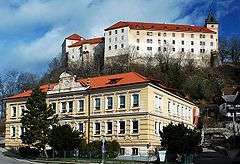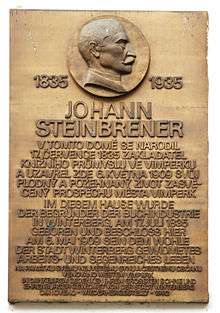Vimperk

Vimperk (Czech pronunciation: [ˈvɪmpɛrk]; German: Winterberg) is a town in the South Bohemian Region of the Czech Republic. In 2000 the town had 8,090 inhabitants. Vimperk is situated in the Šumava region in the Volyňka River valley among the foothills of the Boubín Mountains. The town elevation is 700 metres above sea level.
Vimperk is surrounded by the Šumava National Park, and the park headquarters are located in the Vimperk Castle. The Šumava National Park covers 690.3 km² and is the largest national park in the Czech Republic as well as in Central Europe. The protected lands of Šumava and the Bavarian Forest National Park form what is called the "Green Roof of Europe", which was declared a biosphere reserve by UNESCO in 1990.
Historically Vimperk has been known as an important regional center of trade, being located on the Golden Trail (also called the Salt Path) from Passau. Vimperk is also renowned for its glass-making and printing traditions.
The Vimperk Castle was once an important fortress in southern Bohemia. The oldest part of the castle dates back to about 1195. The Schwarzenbergs were the last private proprietors of the castle.
Climate
Vimperk enjoys a version of humid Continental climate (Dfb) with cool and wet conditions year round. Although frequently falling precipitations are mostly in form of rain, totalling 940 mm, yet also lot of snow falls there. There are four pronounced seasons with quite cold, wet, and relatively sunny winter season, which is replaced during April with sunnier and even wetter warm seasons continuing until October when winter season starts again. Average round the clock temperatures in July stays on mere +15.5 °C and January mean temperatures equals −3.9 °C. The whole year average is 6.1 °C (43.0 °F). This is due to effect of being in the heart of Šumava - Böhmerwald mountain range; the lowest point is 610 meters ASL (2001 feet) and the highest point reaches 978 meters ASL (3209 feet).
| Climate data for Vimperk / Winterberg | |||||||||||||
|---|---|---|---|---|---|---|---|---|---|---|---|---|---|
| Month | Jan | Feb | Mar | Apr | May | Jun | Jul | Aug | Sep | Oct | Nov | Dec | Year |
| Average high °C (°F) | −0.7 (30.7) |
0.8 (33.4) |
6.1 (43) |
11.1 (52) |
16.3 (61.3) |
19.3 (66.7) |
21.0 (69.8) |
20.6 (69.1) |
16.9 (62.4) |
11.2 (52.2) |
4.4 (39.9) |
0.7 (33.3) |
10.6 (51.1) |
| Daily mean °C (°F) | −3.9 (25) |
−2.9 (26.8) |
1.5 (34.7) |
5.8 (42.4) |
10.7 (51.3) |
13.8 (56.8) |
15.5 (59.9) |
15.2 (59.4) |
11.7 (53.1) |
6.8 (44.2) |
1.5 (34.7) |
−2.0 (28.4) |
6.1 (43) |
| Average low °C (°F) | −7.0 (19.4) |
−6.6 (20.1) |
−3.0 (26.6) |
0.6 (33.1) |
5.1 (41.2) |
8.4 (47.1) |
10.1 (50.2) |
9.8 (49.6) |
6.6 (43.9) |
2.4 (36.3) |
−1.4 (29.5) |
−4.7 (23.5) |
1.7 (35.1) |
| Average precipitation mm (inches) | 76 (2.99) |
58 (2.28) |
66 (2.6) |
59 (2.32) |
89 (3.5) |
100 (3.94) |
112 (4.41) |
100 (3.94) |
76 (2.99) |
59 (2.32) |
61 (2.4) |
84 (3.31) |
940 (37.01) |
| Source: Climate-Data.ORG | |||||||||||||
History
The forests in the west and south from the Boubín Mountains were owned from 10th century by the Saint Vitus Church canonry of Prague (Note: This was the ancient canonry of Prague. St. Vitus Cathedral did not yet exist at this time.) Territorial disputes between the Duchy of Bohemia and the Duchy of Bavaria in the 11th century resulted in the loss of much of the local population. Subsequently the provosts at the Vyšehrad Castle enlisted Benedictine monks from the monastery in Winberg nad Řeznem to colonize the region. In 1174 the monks built the Klášterec Commune and established a colony which they named "Windberg" after their old monastery. In 1195 Albrecht III of Luk, a Bavarian count, built a castle which was given the same name. The names of the town and castle subsequently evolved to Winttmberg, Windterberg, Vimberk, and finally to Vimperk. The son and heir of the aforementioned count, Albrecht IV (1198-1242), ordered men to be sent from his Bavarian domains to the Vimperk area to populate and guard these border regions.
Under Albrecht III and Albrecht IV the Golden Trail from Passau to Vimperk was developed, on which salt, oil and other essential goods were transported to Bohemia. After the death of Albrecht IV the Vimperk Castle and surrounding holdings fell to his stepbrother, the Bavarian count Otto, and then in 1252 they returned to the Bohemian Crown. The Bohemian King Ottokar II, gave the Vimperk castle to his loyal servant Purkart of Janovice. Peter of Janovice, his successor, obtained a document on 20 July 1359 from Holy Roman Emperor and Bohemian King Charles IV allowing him to retain Vimperk and Kynžvart castles and the towns of Vimperk, Záblatí and Husinec. The earliest documentation of glass-making in Vimperk also dates from 1359. A decade later, in 1369, Peter's children sold all of the Vimperk holdings to a wealthy Prague citizen named Rothlöw, who in turn sold them in 1378 to the knight Kaplíř of Sulevice.
In 1419, during the conquest of Prachatice by the famous General Jan Žižka of Trocnov, the Hussites succeeded in expelling all Germanic people from the area of Vimperk. For resisting the Hussites the whole town was burned in 1423. It was rebuilt shortly thereafter and in 1424 obtained some privileges from Konrád Kaplíř of Sulevice. From 1419 until the end of Thirty Years' War in 1648, all Germanic people were forbidden from living in Vimperk.
Around 1454, Mikuláš Kaplíř of Sulevice obtained permission from the King Ladislav I of Bohemia the authority to collect toll on the Golden Trail. The castle and town of Vimperk were granted to Mikuláš Kaplíř of Sulevice and Peter Kaplíř by King Jiří of Poděbrady. Peter Kaplíř was defeated by the Catholic Bishop of Passau, and on 18 September 1468 the town of Vimperk (which was not yet walled) was conquered and burned again by the Bavarian forces. Afterwards, Peter Kaplíř rebuilt the town and fortified it. According to his request, on 24 April 1479 Vimperk was granted the rights of a city by King Vladislav II Jagellonský of Bohemia.
In 1494 the Kaplíř lords sold the castle and town to the knights of Malovec and Hradec. In 1502 the lord of Vimperk, Zdeněk, joined with the lords of Prachatice to ask for changes in regulations concerning the Golden Trail. King Vladislav II Jagellonský agreed to allow merchants the freedom to choose which town along the path to deliver their goods to (the path having been extended well beyond Vimperk prior to 1450). Due to this decision, Vimperk enjoyed a period of tremendous prosperity. In 1484 a printing operation was established which produced the first printed Czech] calendar.
During the war in 1547 led by Czech Protestants against the King Ferdinand I of Habsburg, the citizens of Vimperk sided with the Czech Protestants. After Ferdinand's eventual triumph he gained Vimperk among his spoils. in 1553 he sold Vimperk to Jáchym of Hradec, but it was seized by Vilém of Rožmberk (called Wilhelm von Rosenberg in German). Vilém's brother Petr Vok of Rožmberk (also known as Peter Vok von Rosenberg, the last member of the House of Rožmberk/Rosenberg) sold the town in 1601 to Volf Novohradský of Kolovraty, who sided with the Czech Protestants during the rebellion of 1618. On 10 July 1619 Vimperk Castle was occupied by the imperial forces under Illow. On 22 and 23 October 1619, the castle and town were regained by Protestant forces under Arnošt of Mannsfeld, but the main castle was horribly damaged as a consequence of the battle.
Between 1622 and 1624 Jáchym Novohradský of Kolovraty built new castle buildings over portions of the castle that had been destroyed. This construction and other expensive activities ruined him financially so that he was forced in to sell the castle in 1630 to Oldřich, Count of Eggenberg. The Eggenbergs owned Vimperk Castle until 1719, when the House of Eggenberg died out and all of the Eggenberg holdings, including Český Krumlov, fell to Schwarzenbergs.
In 1857 the town of Vimperk suffered yet another fire which caused extensive damage to many of the buildings on the main town square. Emperor Franz Joseph visited Vimperk to see the extent of the damage and authorized imperial funding to assist with repairs and reconstruction.
In 1938 the German military, by order of the German Nazi government, expelled all non-Germanic persons from Vimperk claiming it was Sudeten German territory. At the end of World War II, all Germanic people were expelled from Vimperk.
In 1947 the Vimperk Castle was nationalized by the Czechoslovak state. A part of the property is currently a museum, and the headquarters of the Šumava National Park are also located there.
People

- Adam Franz of Schwarzenberg (1680–1732) - who repaired the Vimperk Castle and renovated some buildings in Baroque style.
- Dr. Albert Popper (1808–1889) - Mayor of Vimperk.
- Johann Steinbrener (1835-1909) – Established a huge printing operation in Vimperk in 1855 that printed books in about 30 languages.
- Josef Puhani (1878-1947), Author of "Chronologische Notizen zur Geschichte von Winterberg und Umgebung, 1195-1926 [Chronological Notes on the History of Vimperk and Its Surroundings, 1195-1926]"; http://www.kohoutikriz.org/priloha/puhan.php ; http://www.kohoutikriz.org/data/w_puhan.php
External links
| Wikimedia Commons has media related to Vimperk. |
- Municipal website (cs, en, de)
- Prachatice District (English)
- News (cs)
Coordinates: 49°03′N 13°47′E / 49.050°N 13.783°E